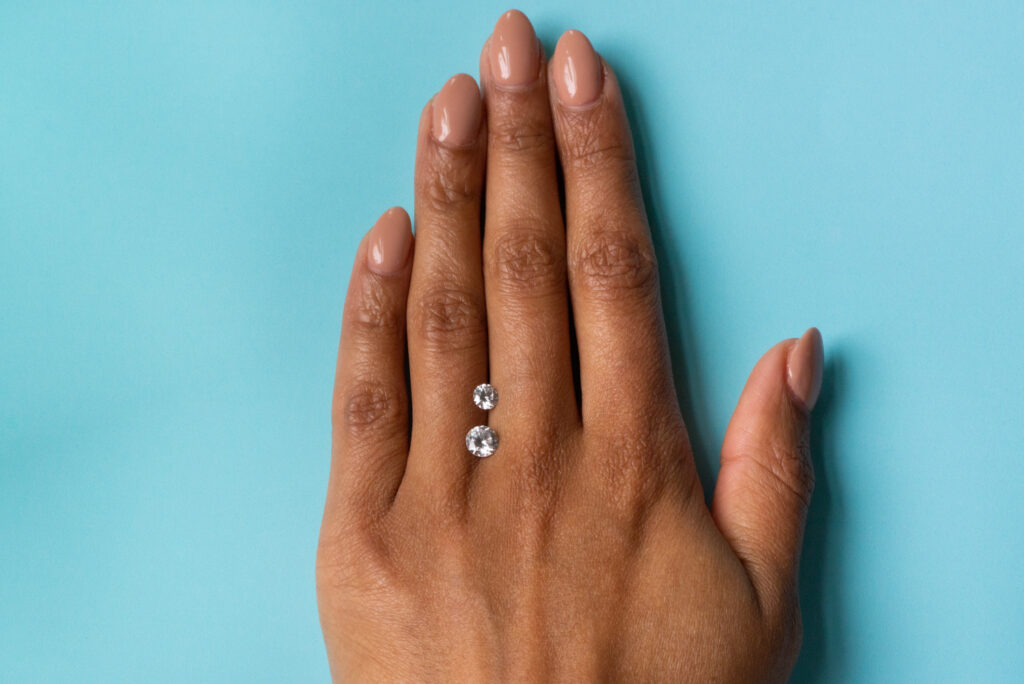
Understanding the 4 C’s When Diamond Shopping at Bario Neal
Just like snowflakes, no two diamonds are identical. With so many options to choose from regarding shape, color, size and style preferences, it can be difficult, and perhaps a little daunting, to purchase diamond rings without a little guidance. Because there are so many variations, gemologists have narrowed down the assessment of diamonds into four different categories, known as the 4 Cs, that are used to best determine and rate the overall quality of a diamond gemstone. All of Bario Neal’s natural polished diamonds are GIA certified (our Lab Grown diamonds come with IGI or GCAL certifications) and each “C” is given its own grade. Raw, uncut diamonds are unique in many ways, and don’t receive gradings because they are not cut and polished.

The first of the 4 Cs is Cut, which refers to the facets, cuts, and reflectiveness of a diamond. This first C is a big one as it directly correlates to the diamond’s overall sparkle. Regardless of the occasion, one word you might hear an awful lot when shopping for a diamond, be it a diamond engagement ring or a self-love-inspired custom diamond necklace– is “fire.” Fire refers to that sort of radiant, bright shimmer that occurs when light refracts inside a diamond. Another term used to describe a diamond’s brilliance is “scintillation”, aka sparkle. The fire of a diamond and all the ways that it shimmers against the light are directly correlated with how well a diamond has been cut.
The next of the four C’s is Color. While you might imagine a diamond being clear and colorless, any trace amount of other elements will change its color slightly. This includes yellows, grays, and browns. Color in diamonds is ranked by hue, tone, saturation, and the diamond color scale. Jewelers can tell you, without getting too into the nitty gritty, what sort of color quality your diamond has by referring to the International Color Scale. This scale runs along the alphabet, starting with D-F being absolutely colorless, and increasing in color up through to Z. The lower the letter, the less color.

And then there’s Clarity, which can be a bit of a difficult concept to wrap your head around if you’re not fully immersed in the world of diamond grading. It’s a lofty concept, but it basically comes down to minor flaws or imperfections on the interior and exterior diamond. Gemologists magnify, inspect, and map their characteristics on a “diamond plot”. From there, diamonds are assessed for their clarity on a rating scale, which ranges from F (Flawless) to I3 (Flaws Included). Inclusions, which are tiny crystals which make their way into diamonds as they form, also affect a diamond’s clarity grade. These little quirks within diamonds detract from clarity but add to the uniqueness and history of a diamond (a natural inclusion is at least one million years old!). Depending on what you’re looking for when you’re shopping for a diamond, clarity and inclusions can be both a marker of perfection or the natural beauty of a diamond! In fact, “salt and pepper” diamonds, which have come into vogue in recent years, celebrate inclusions. The added flecks of color display in unique patterns, adding a bonus layer of uniqueness to the diamond for your custom jewelry. When it comes to inclusions, and clarity in general, there’s no right or wrong way to look at them, it’s more just a matter of preference.
The last ‘C’ of the four is Carat, a quintessential jewelry vocab word that shoppers might know in theory but not fully understand. Carat (ct.) became the standard unit for measuring the weight of diamonds some time in the early 20th century, and while it’s often thought that the bigger the diamond the higher the carat, shape and density heavily affect a diamond’s carat weight. Not all gemstones weigh in at the same carat measurements. While a round-cut diamond might weigh in at 1.00ct and measure at 6 mm, a sapphire of the same cut and weight would measure at 6.5mm. Carat is, nevertheless, probably the most objective of the 4 c’s. The higher the carat the bigger the diamond volume. Whether you’re looking for a subtle engagement ring or a bold pair of showstopper diamond earrings, you can often increase or decrease the total carats and see a reflected change in the size and stature of your piece.
Knowing your way around the 4 C’s is essential in making an informed decision about what sort of diamond you’re looking for, and helps your jeweler guide you through the process of picking out a gemstone for your custom diamond jewelry. That being said, the offerings from jeweler to jeweler will vary, and what you value in terms of clarity, brilliance, or color will greatly impact where your diamond jewelry journey will lead you.
For Bario Neal jewelry, we typically work with I color or better, which will always look ostensibly white. This standard is a great starting point for those who are interested in buying custom fine jewelry with both high quality and an accessible price point. We work exclusively with SI1 clarity or better, with no imperfections visible to the naked eye, and grade “Good” cut or better, so that all facets are where they are meant to be- in proportion with no visibly wonky imperfections. Of course, for custom jewelry designs, these gradings factor heavily into the pricing, and the 4 C’s (especially color and clarity) will depend heavily on how much you’re looking to spend to secure the highest ranking within their own standards of measurements. Bario Neal works closely with our customers to ensure that their choice diamond gemstone, whatever the occasion or piece, is up to their standard. Even without an encyclopedic knowledge of the 4 C’s, diamond shopping shouldn’t be difficult. Our team, both in-store at our Brooklyn and Philadelphia shops and online, can help to ease you into the process.